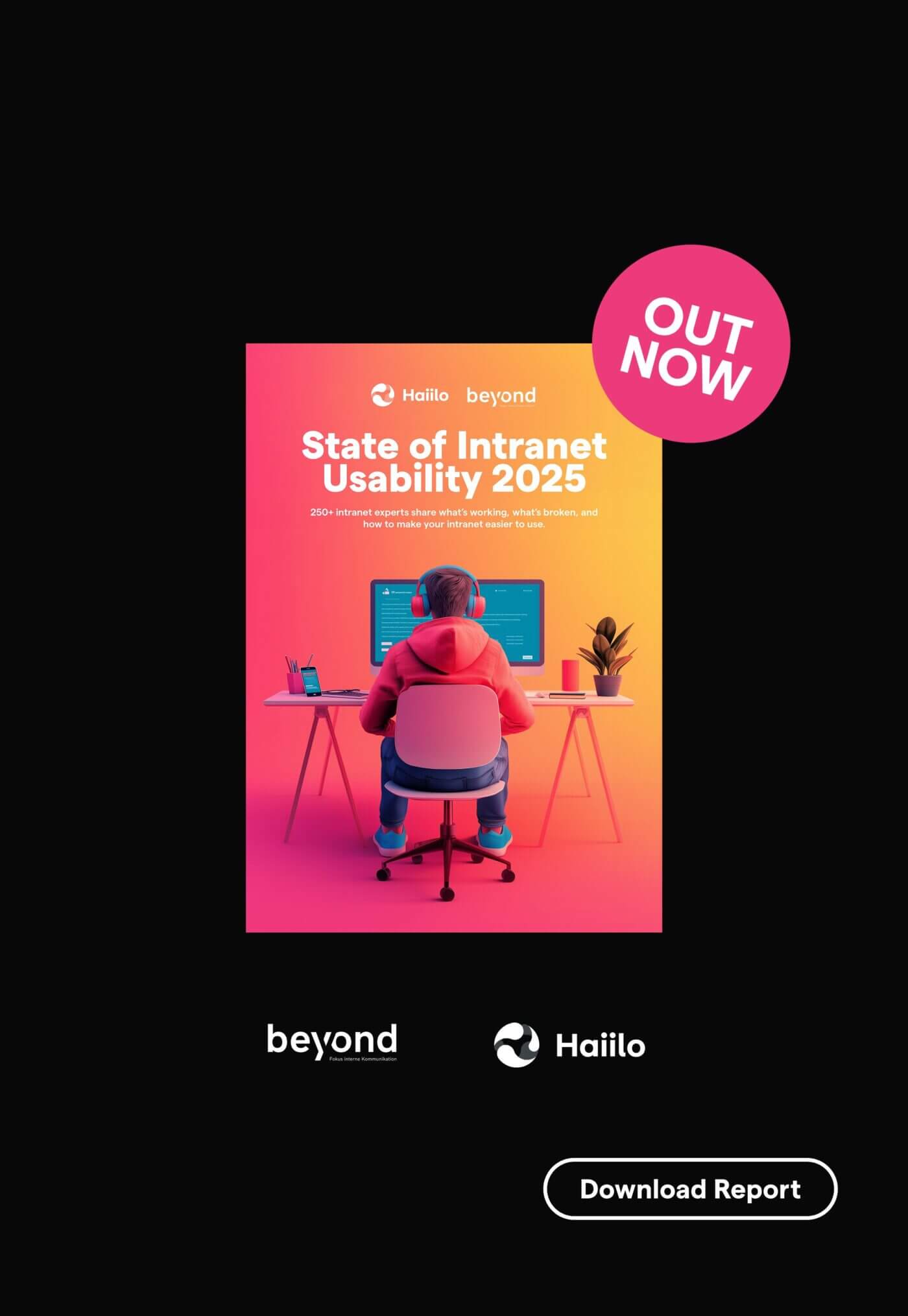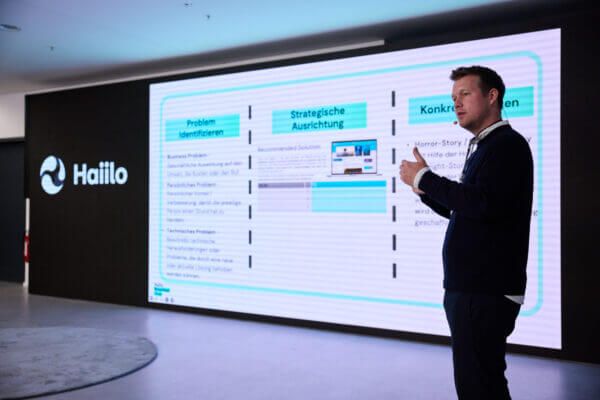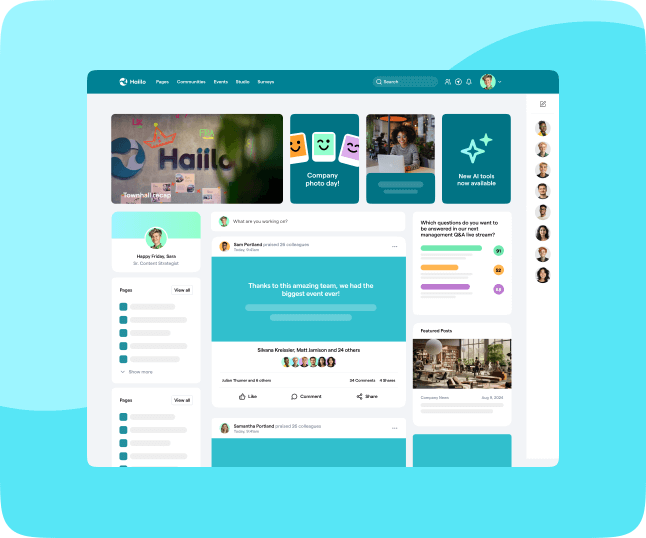Intranets are supposed to make work easier. But too often, they slow people down.
Whether it’s clunky navigation, poor mobile performance, or a search bar that might as well be a black hole, most intranets still struggle to deliver what employees actually need: a fast, intuitive, and trustworthy way to find information and stay connected.
According to the State of Intranet Usability 2025 report from the School for Communication and Management (SCM) and Haiilo, most organizations are still a long way from that goal. The good news is that the data we’ve collected shows exactly where you can start improving.
💡Read: Your guide to building an intranet in 2025
Let’s look at what’s broken and how to make your intranet actually usable in 2026.
1. Start with the user experience (not the features)
Only 10.1% of intranet experts rated their platform’s usability as “excellent”. Nearly a third said it was “average”, and another 9.9% called it “poor”.
That means almost half of employees are using systems that frustrate them on a daily basis. And when something’s hard to use, people simply stop using it. Shadow channels pop up. WhatsApp groups take over. Emails multiply.
Usability is the foundation, not a feature. It’s what determines whether your intranet helps people do their jobs or gathers dust in the corner.
🧭 Quick win: Simplify navigation. Reduce the number of clicks to reach important pages. Test your homepage layout with real users and track where they drop off.
2. Fix onboarding friction
If you’ve ever watched a new colleague get lost on the intranet, you know how the pain.
Over half (53%) of new employees need support just to find their way around, and 17.4% take weeks before feeling confident enough to use it. That’s time lost for them and for the people helping them.
In 2026, a good intranet should feel self-explanatory. Fewer PDFs, more guided tours. Fewer “Where do I find this?” messages, more intuitive menus and onboarding prompts.
🧭 Quick win: Create a “Start Here” experience for new joiners – a page that brings together the top 10 most-used links, tools, and policies. Bonus points if it’s accessible from mobile.
3. Prioritize mobile usability
Hybrid and frontline work aren’t new anymore. Yet only 11.6% of respondents said they were “very satisfied” with their intranet’s mobile experience. Another 30% were actively dissatisfied.
That’s a big problem when so much of your workforce isn’t sitting behind a desk. Today, mobile usability is a requirement.
🧭 Quick win: Audit your intranet on mobile. Can people read news without pinching and zooming? Submit forms without switching to desktop? If not, you’ve got work to do.
💡Read: Your intranet has a UX problem. Here’s how to fix it.
4. Make search actually work
Search is where intranet usability succeeds or fails. And right now, it’s failing for most organizations.
Only 9.1% of respondents rated their intranet search as “very good”. Another 17% said they can only find content “with extra effort,” and 22.7% often find nothing at all.
No surprise, then, that 57% of people cited poor search functionality as their biggest usability hurdle, followed by unclear navigation (44%) and lack of personalization (38%).
🧭 Quick win: Start by cleaning up your content. Outdated, duplicated, or badly labeled pages are your biggest stumbling blocks. Invest in smarter, AI-assisted search that understands intent, not just keywords.
5. Use data, not guesswork
Almost half (46.6%) of organizations don’t measure intranet usability at all.
And among those that do, only 27.9% run user surveys, 15.7% measure mobile usage, and just 7% track search success rates. Most teams still rely on basic metrics like page views or clicks, which tell you what happened, but not why.
If you want to improve intranet usability in 2026, you need better data. Measure task completion times, search accuracy, and user sentiment. Ask employees how easy it was to find or do something.
🧭 Quick win: Pick one KPI that actually reflects usability. For example, “% of employees who found what they needed in under 2 minutes.” Track it monthly. Watch how it changes.
6. Turn feedback into strategy
Collecting feedback is easy. Acting on it is where most teams come unstuck.
Even among organizations that gather usability data, 35% admit that they never act on it. Top reasons are lack of resources (53.7%), technical limitations (39%), and low internal priority (23.2%).
It’s a leadership issue, not just a tech issue. Usability needs ownership, budget, and clear accountability. When it’s everyone’s job, it’s no one’s responsibility.
🧭 Quick win: Assign one person or small team as your “Intranet Experience Owners.” Give them clear KPIs (like satisfaction scores or task completion rates) and the authority to drive change.
7. Keep content clean and current
Outdated, messy content is the silent killer of usability. Employees stop trusting the intranet when links break, pages contradict each other, or news feels stale.
The report found that most teams already know this. Over 70% could name specific actions to improve usability, and content clean-up was one of the most common answers.
🧭 Quick win: Run a quarterly content audit. Archive what’s outdated, merge duplicates, and apply consistent naming conventions. A smaller, cleaner intranet is almost always a more usable one.
8. Make usability everyone’s business
Usability shouldn’t sit in a corner of IT or Comms. It’s a shared responsibility across departments – from HR and design to leadership and frontline managers.
When you include employees in usability improvements, you get platforms people actually want to use. That’s when the intranet stops being “that place for documents” and becomes a genuinely useful part of daily work.
🤝Quick win: Host a “Usability Week.” Run short feedback sessions with different departments, gather their pain points, and show them how you’re fixing them. Visibility builds trust.
Key takeaways
The State of Intranet Usability 2025 report makes one thing clear: most organizations already know what’s broken. The challenge is acting on it.
Fixing usability doesn’t need a complete relaunch. It requires focus, ownership, and a mindset shift from maintaining an intranet to designing an experience.
So as you plan your intranet strategy for 2026, remember:
- If people can’t find it, they won’t use it
- If it doesn’t work on mobile, it doesn’t work
- And if you don’t measure usability, you can’t improve it
Because an intranet is the foundation of a connected, informed, and productive workplace.
The intranet everyone can use – and actually will
Haiilo’s employee engagement platform is simple, intuitive, and built for real people. It’s fast to launch, easy to use, and loved by teams everywhere.
- Instant adoption – feels familiar from day one
- Effortless navigation – find what you need in seconds
- Smart, mobile, and accessible – works for everyone, everywhere
“Simple and intuitive.” — Clearbox
Want an intranet people actually use?






